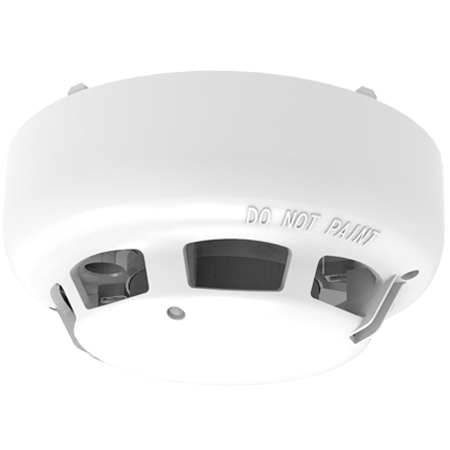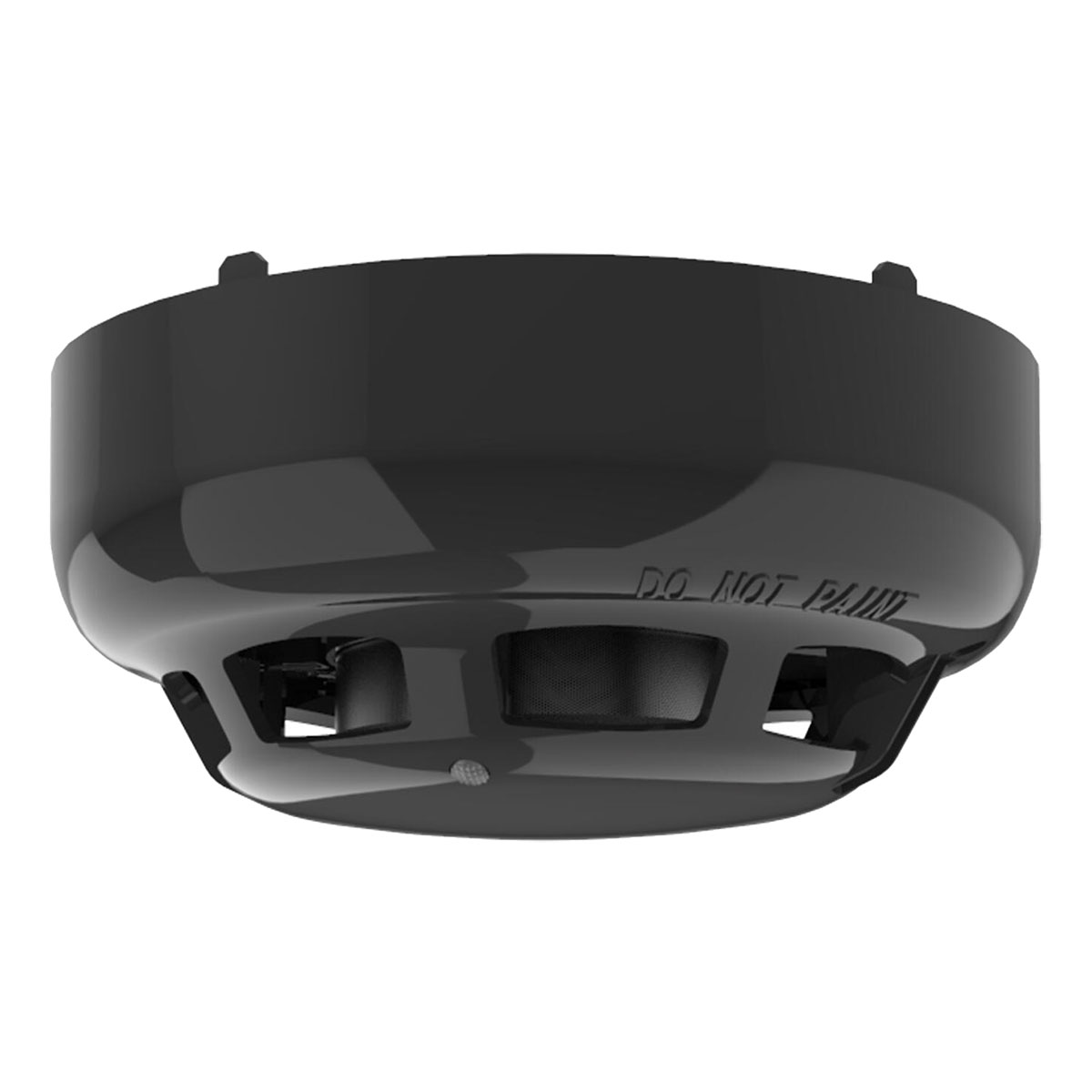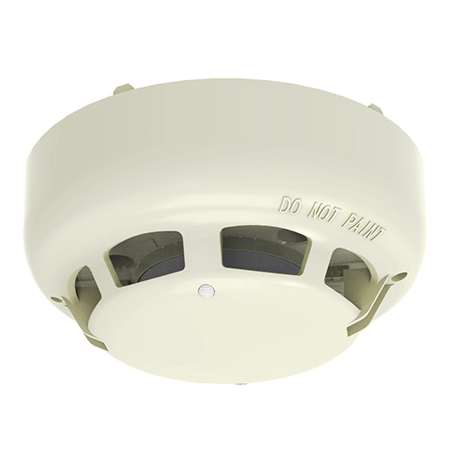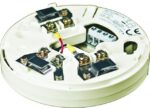Hochiki ESP Addressable Smoke Detector
Summary
The Hochiki ALN-EN is an advanced analogue addressable photoelectric smoke sensor that incorporates the latest High Performance Chamber Technology, representing a significant evolution in smoke detection capabilities. Fully compatible with Hochiki’s ESP (Enhanced Systems Protocol) Analogue Addressable Protocol, this intelligent sensor removes the need for ionisation smoke sensors in the majority of applications, offering superior performance and enhanced reliability across a wide range of environments.
At the heart of the ALN-EN is Hochiki’s newest high performance smoke chamber, which features an innovative removable design for simplified cleaning and maintenance. The unique improved baffle design allows smoke particles to enter the chamber efficiently while effectively blocking out ambient light that could cause false alarms. This advanced chamber technology enables the sensor threshold level to be increased, significantly improving the signal-to-noise ratio and substantially reducing susceptibility to nuisance alarms that can disrupt operations and undermine confidence in fire detection systems.
The ALN-EN features twin LEDs that provide 360-degree visibility, displaying green when the sensor is being polled by the control panel and red during fire alarm conditions. This clear visual indication assists with system commissioning, maintenance, and emergency response. The sensor incorporates variable sensitivity settings ranging from 2% to 4.5% per meter, allowing precise calibration to suit specific environmental conditions and application requirements. With its locking mechanism between sensor and base, electronically addressed architecture, and panel-controlled pulsing or non-pulsing LED operation, the ALN-EN delivers comprehensive functionality for modern intelligent fire detection systems.
Features
- Advanced photoelectric smoke detection technology
- High performance chamber eliminates need for ionisation sensors
- Removable smoke chamber for easy cleaning and replacement
- Unique improved baffle design blocks ambient light
- Efficient smoke entry while preventing false alarms
- Twin LED indicators for 360-degree visibility
- Green LED when polling, red LED in fire condition
- Pulsing or non-pulsing LED operation controlled from panel
- Variable sensitivity from 2% to 4.5% per meter
- Improved signal-to-noise ratio reduces false alarms
- Electronically addressed for individual device identification
- Locking mechanism secures sensor to base
- Compatible with Hochiki ESP analogue addressable protocol
- Digital communications using ESP protocol
- Low quiescent current of 400 μA typical
- Ultra-low power mode at 120 μA typical
- Operating voltage range 17 to 41 VDC
- Wide operating temperature range -10°C to +50°C
- Operates in humidity up to 95% RH non-condensing
- IP42 ingress protection rating
- Available in ivory, white or black colour options
- Compact 100mm diameter, 45mm height profile
- Lightweight construction at 95 grams
- Durable ABS case material
- Compatible with multiple Hochiki base options
- Base fixing centres 48 to 74mm adjustable
- LPCB and VdS approved
- EN54-7 compliant for wind exposure
- Storage temperature range -30°C to +60°C
- Professional installation and maintenance friendly
Video
What does ESP stand for in Hochiki’s sensor range?
ESP stands for Enhanced Systems Protocol, which is Hochiki’s Open Protocol communication platform used in their analogue addressable sensor range.
How many types of sensors are in the ESP sensor range?
There are four types of sensors in the ESP sensor range: optical smoke, heat, smoke and heat multi, and smoke heat and CO multi.
What special application variants are available for the ESP sensors?
Special application variants include marine approved, seal capable, and versions with built-in short circuit isolators.
What colors are the ESP sensors and bases available in?
The sensors and bases are available in ivory, white, or black.
How is sensor addressing achieved for ESP sensors?
Sensor addressing is achieved electronically using a TCH B200 programmer, and the address is stored in the sensor.
What is the detection principle used in the optical smoke sensors?
The optical smoke sensors use a backscatter detection principle, where light reflected off smoke particles is detected.
What sensing elements are used inside the heat and multi-sensors?
Thermistors are used as sensing elements inside the heat and multi-sensors to detect heat changes.
What additional sensing element does the newest multi-sensor, the ACD, feature?
The ACD features a CO sensing element that detects carbon monoxide released at early stages of a smouldering fire.
How can the fire threshold of ESP sensors be adjusted?
The fire threshold can be adjusted to increase or decrease sensitivity based on percent obscuration per meter for optical sensors or temperature for heat sensors, either at the fire alarm control panel or using programming software.
What is drift compensation in ESP sensors?
Drift compensation is a feature that allows the sensor electronics to shift the fire threshold level and baseline to maintain optimum performance if the sensor chamber and optics become contaminated over time.
What bases do most ESP sensors fit onto?
Most ESP sensors fit onto the standard electronics-free base YBN-R3, while sensors with short circuit isolators require the YB-VR4 base.
How do sounder bases auto-address themselves when combined with ESP sensors?
When combined, the sounder base auto-addresses itself by setting its address to the sensor address plus 127, allowing independent control via the ESP protocol.
FAQ
What is the advantage of photoelectric detection over ionisation?
The ALN-EN’s photoelectric detection technology offers several advantages over traditional ionisation sensors. Photoelectric sensors are more effective at detecting slow-smoldering fires that produce larger smoke particles, which are common in residential and commercial settings. They are less prone to false alarms from cooking fumes, steam, and dust compared to ionisation sensors. Additionally, photoelectric sensors do not contain radioactive material, eliminating disposal and regulatory concerns associated with ionisation detectors. The ALN-EN’s High Performance Chamber Technology provides such improved sensitivity and reliability that it removes the need for ionisation sensors in most applications.
Why is the smoke chamber removable?
The removable smoke chamber design is a significant maintenance advantage. During routine servicing, the chamber can be easily detached from the sensor head for thorough cleaning without requiring complete detector removal from the ceiling or dismantling of wiring connections. This simplifies maintenance procedures, reduces service time, and ensures the chamber can be cleaned effectively to maintain optimal detection performance. If a chamber becomes damaged or contaminated beyond cleaning, it can be replaced without replacing the entire sensor, reducing long-term maintenance costs.
What do the different LED colours indicate?
The ALN-EN features twin LEDs that provide clear status indication visible from 360 degrees. The LEDs display green when the sensor is being polled by the fire alarm control panel, confirming normal communication and operation. During a fire alarm condition, the LEDs turn red to provide immediate visual confirmation of the detector in alarm. The LED operation can be set to either pulsing or non-pulsing mode from the control panel, allowing customization based on site requirements. This dual-colour indication assists engineers during commissioning, helps maintenance personnel verify device operation, and aids emergency responders in quickly identifying the alarm source.
What is variable sensitivity and why is it important?
Variable sensitivity allows the ALN-EN to be calibrated from 2% to 4.5% obscuration per meter to suit different environmental conditions and application requirements. Lower sensitivity settings (higher percentage) are appropriate for areas prone to dust, vehicle exhaust, or other particulate matter that might cause nuisance alarms. Higher sensitivity settings (lower percentage) provide earlier detection in clean environments or where rapid fire detection is critical. This flexibility ensures optimal performance across diverse applications, from warehouses to offices, without requiring different detector models. The sensitivity can be adjusted through the control panel without physical access to the detector.
Which fire alarm control panels is the ALN-EN compatible with?
The ALN-EN is designed for use with Hochiki fire alarm control panels that support the ESP (Enhanced Systems Protocol) analogue addressable protocol. This includes Hochiki’s range of intelligent fire alarm systems such as the FIREscape addressable panels and other ESP-compatible control equipment. The digital communication protocol allows the panel to receive detailed analogue information from the sensor, monitor device health, adjust sensitivity, control LED operation, and receive early warning of developing fire conditions. Always verify compatibility with your specific control panel model before installation.
What bases are compatible with the ALN-EN?
The ALN-EN is compatible with several Hochiki detector bases including the YBN-R/3 (standard base), YBO-R/SCI (short circuit isolator base), YBO-BS (sounder base), YBO-BSB2 (beacon sounder base), and YBN-R/3(SCI) (standard base with isolator). The adjustable base fixing centres from 48mm to 74mm provide flexibility for mounting on various back boxes and ceiling installations. The sensor features a locking mechanism that securely attaches to the base, preventing accidental removal while allowing authorized detachment for maintenance.
Can the ALN-EN be used in dusty or humid environments?
The ALN-EN is designed to operate in demanding conditions with humidity up to 95% RH non-condensing at 40°C and an IP42 ingress protection rating providing protection against solid objects over 1mm and water dripping at an angle up to 15 degrees. However, in particularly dusty environments, the variable sensitivity feature should be utilized to set an appropriate threshold that balances detection capability with false alarm prevention. Regular maintenance and chamber cleaning will ensure optimal performance in challenging environments. For extremely harsh conditions, consultation with Hochiki or a fire system designer is recommended to ensure the ALN-EN is appropriate for the specific application.
How does the improved signal-to-noise ratio reduce false alarms?
The High Performance Chamber Technology in the ALN-EN allows the sensor threshold level to be increased while maintaining excellent smoke detection capability. This means the sensor can distinguish between actual smoke particles from fire and background “noise” such as dust, water vapor, or other airborne particles more effectively. By improving the signal-to-noise ratio, the sensor is less likely to misinterpret environmental conditions as fire, significantly reducing false alarms. This is particularly valuable in environments with challenging conditions like kitchens, manufacturing areas, or locations with temperature fluctuations that might trigger less sophisticated detectors.
What is the typical current consumption and why does it matter?
The ALN-EN has a low quiescent current of 400 μA typical during normal monitoring operation, with an ultra-low power mode of 120 μA typical. This low power consumption is important for several reasons: it allows more devices to be connected to a single loop circuit without exceeding power supply capacity, reduces overall system power requirements and operating costs, minimizes heat generation in the detector, and ensures the system can operate longer on backup battery power during mains failure. The efficient power design is particularly beneficial in large installations with hundreds of devices.
Are there different colour options available and why?
Yes, the ALN-EN is available in three colour options: ivory (ALN-EN), white (ALN-EN(WHT)), and black (ALN-EN(BLK)). These options allow the detector to be matched with ceiling colours and interior design aesthetics, making them less visually obtrusive while maintaining functionality. Ivory is the traditional standard colour, white provides a clean modern appearance suitable for contemporary interiors, and black is ideal for dark ceilings, entertainment venues, or locations where a discreet appearance is preferred. All colour variants offer identical performance and specifications.
Specifications
- Model Number: ALN-EN
- Product Type: Analogue addressable photoelectric smoke sensor
- Manufacturer: Hochiki
- Detection Technology: Photoelectric with High Performance Chamber
- Protocol Compatibility: Hochiki ESP (Enhanced Systems Protocol)
- Ordering Code: ALN-EN (Ivory), ALN-EN(WHT) (White), ALN-EN(BLK) (Black)
- Operating Voltage: 17 – 41 VDC
- Low Power Mode (typical): 120 μA
- Quiescent Current (typical): 400 μA
- Alarm Current: 9.1 mA (excluding remote indicator, controlled by CIE)
- Transmission Method: Digital Communications using ESP
- Operating Temperature Range: -10°C to +50°C
- Operating Humidity: 95% RH Non-Condensing (at 40°C)
- Sensitivity Levels: 2%/m to 4.5%/m (variable)
- Storage Temperature Range: -30°C to +60°C
- Storage Humidity: <80% RH at 60°C
- Colour Options: Ivory, White or Black
- Case Material: ABS
- Weight: 95g
- Diameter: 100mm
- Height: 45mm
- Compatible Bases: YBN-R/3, YBO-R/SCI, YBO-BS, YBO-BSB2, YBN-R/3(SCI)
- Base Fixing Centres: 48 ~ 74mm (adjustable)
- Led Indicators: Twin LEDs with 360° visibility
- Led Colours: Green (polling), Red (fire alarm)
- Led Operation: Pulsing/non-pulsing controlled from panel
- Chamber Design: Removable High Performance chamber
- Baffle Design: Improved design blocks ambient light
- Locking Mechanism: Sensor to base locking feature
- Addressing: Electronically addressed
- Approvals: LPCB, VdS
- Wind Exposure (ref En54-7): 1 ± 0.2 m s-1
- Ingress Protection Rating: IP42
- Standards Compliance: EN54-7
Downloads
- Datasheet (Adobe PDF)











